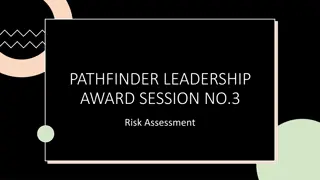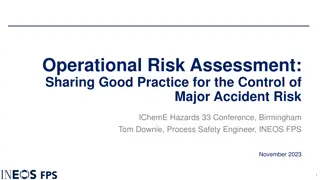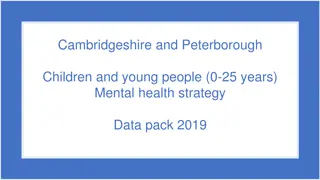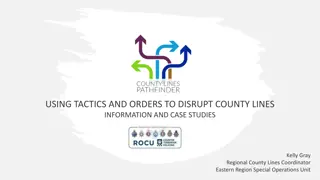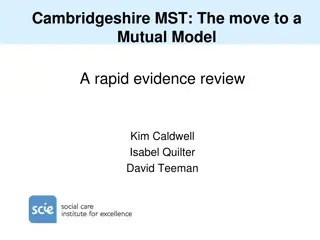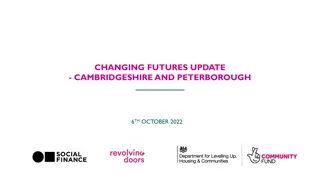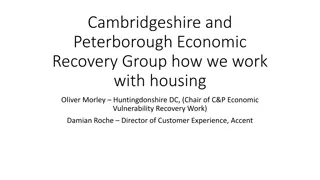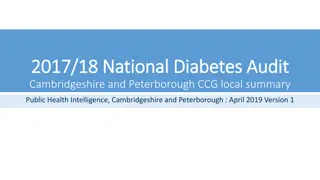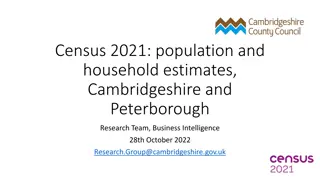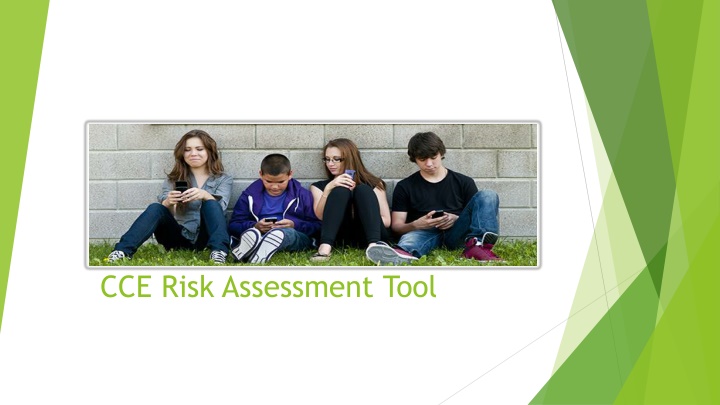
Assessing Risk of Criminal Exploitation in Children
Learn about the Child Safeguarding Practice Review Panel's findings on safeguarding children at risk of criminal exploitation. Discover the current CCE risk assessment tool ratings and regional comparisons for areas like Essex, Suffolk, and Norfolk. Understand the levels of risk and indicators used to assess vulnerability in children facing exploitation.
Download Presentation

Please find below an Image/Link to download the presentation.
The content on the website is provided AS IS for your information and personal use only. It may not be sold, licensed, or shared on other websites without obtaining consent from the author. If you encounter any issues during the download, it is possible that the publisher has removed the file from their server.
You are allowed to download the files provided on this website for personal or commercial use, subject to the condition that they are used lawfully. All files are the property of their respective owners.
The content on the website is provided AS IS for your information and personal use only. It may not be sold, licensed, or shared on other websites without obtaining consent from the author.
E N D
Presentation Transcript
It Was Hard to Escape Safeguarding Children at Risk from Criminal Exploitation by The Child Safeguarding Practice Review Panel The work of the national Child Safeguarding Practice Review Panel draws on the notifications, rapid reviews, practice reviews and serious case reviews that we receive every day. Our children face a number of challenges to their safety and wellbeing today none more complex and damaging than criminal exploitation. Being drawn into exploitative situations, where children can be both victims and perpetrators of serious harm, can have severe consequences for them and for their families, friends and communities. Relevant key findings: Ethnicity and gender appear to be factors Known risk factors around vulnerability don t always act as predictors Exclusion from mainstream school is seen as a trigger point for risk of serious harm Responding to the critical moment
Current CCE risk assessment tool ratings Significant: Evidence / disclosure suggests that the child is at immediate and / or continuing risk of sexual exploitation. The child / young person is engaged in high risk situations / relationships / risk taking behaviour. Evidence / assessments, suggests that the child is experiencing exploitation (they may not recognise this). Moderate: Child is vulnerable to being exploited / but there are not immediate/ urgent safeguarding concerns. There is evidence the child / young person may experience protective factors, but circumstances and / or behaviours place him/her at risk of exploitation. Emerging: Some evidence that the child or young person is at risk of exploitation and / or places him/herself at risk. Some concerns that the child/ young person is at risk of being targeted or groomed, but there are positive protective factors in the child s life. The child / young person may require a referral to targeted early intervention services for education / intervention.
Regional comparisons - ratings Essex has 4 ratings (though only specific to CSE): Suffolk has 3 ratings (though only specific to CSE): Actual abuse taking place Low - At risk of being targeted and groomed. Child or Young Person presenting with 1 to 4 indicators High - Indicators of association with individuals or groups known to be engaging in the sexual exploitation of YP Medium - appears to be targeted for opportunistic abuse through the exchange of sex for drugs, accommodation (overnight stays) and goods etc. Coercion and control are highly likely to be significant factors. Child or young person presenting with more than 5 indicators Medium Indicators of association with individuals or groups suspected of engaging in the sexual exploitation of YP Standard No indicators however, there are specific aspects of thinking, behaviour, appearance, possessions and/or situation that give cause for concern. Norfolk has 4 ratings: High - already experiencing exploitation and coercive control or whose heightened vulnerability places them at escalated risk of such approaches. Child or young person presenting with several indicators from all categories and 1 or more high risk indicator/s. High YP currently exposed to exploitation/serious youth violence. The risk to safety is significant. Medium Evidence YP is likely to be targeted. YP s health and development likely to be significantly impaired without support. Standard At this stage there is no evidence but may be at risk in future due to presence of vulnerability factors. YP requires support to increase resilience. Non CCE/CSE no evidence
Cambridgeshire CCE risk assessment tool content Areas of vulnerability considered: Running away/going missing Coercion/control Contact with abusive person s and/or risky environments Substance misuse Education Use of social media/technology Sexual Health/sexualised risk taking Emotional and physical health Accommodation and family relationships Offending/weapons/criminal activity Community/social isolation factors
Regional comparisons - content Norfolk Missing from school/home, parents not reporting missing episodes. Coercion or control by others Other vulnerabilities such as LAC, SEN Missing and found in another area. Frequenting risky locations or environments including online Association with others who present a risk or are at risk of exploitation Lack of engagement with education and/or employment Use of alcohol, possession or use of drugs Accommodation and/or family relationship issues/cuckooing Dangerous use of social media Unlawful sexual activity and or sexual activity with perpetrators of exploitation Offending/weapons/criminal activity/perpetrator serious violence or peer abuse. Issues with emotional and/or physical health Evidence/intelligence to indicate County Lines involvement Community and social isolation factors Unexplained income/possessions/mobile phones or lifestyle Concern for exploitation and/or Human Trafficking Victim of sexual crime or serious violence Witness of sexual or serious violence.
Regional comparisons content Essex (CSE focussed) Vulnerabilities checklist: Who is involved? No positive relationship with nurturing adult Information about the child: LAC, refugee, asylum seeker, SEN, culture, religion, sexual orientation, etc. Disabilities physical/learning/communication Information about associates: Names, Aliases, nicknames, online names, address, vehicle details, places they are known to frequent. Young carer Unsure/unable to tell people about gender identity or sexual orientation Low self esteem, bullied, victim of hate based behaviour Model of CSE: Inappropriate Relationship, Organised and trafficking, gangs and groups, peer on peer, older boyfriend/girlfriend, online grooming. Disconnecting from support networks Living in chaotic or dysfunctional household/unsuitable or inappropriate accommodation Health, including emotional and mental health Behaviour and experiences, including substance use, criminal behaviour and having been a victim. Gang associations through family, peers or intimate relationships. Locations known to frequent Previous or current contact with public services Appearance and possessions. Family situation and history
Regional comparisons content Suffolk (CSE focussed) Unsafe use of the internet Low indicators Change of appearance Breakdown of relationship with family/Sudden change of friendship group Physical injuries without clear explanation Sexual offending behaviour/Has been sexually assaulted Whereabouts unclear or unknown High indicators Absence/exclusion from school Disclosure of assault including withdrawal of allegation Experimenting with drugs or alcohol Offering to have sex for money then running off before sex takes place Chronic low self-esteem/low mood/self harming/suicide attempts/eating disorders Have multiple STI s/miscarriages/terminations Unaccounted for monies or goods Groomed/abuse via the internet or mobile technology Lack of awareness / understanding of being safe Forms friendships/associations with older teens/adults No plausible explanation of source of funding Access to premises not known to parent/carer and/or being taken to hotels, clubs, resorts, holiday accommodation Association with other young people at risk Medium indicators Entering/leaving vehicles driven by unknown adults Repeat offending behaviour including association with gang members Frequenting areas known for risky activities Demonstrating age inappropriate sexual knowledge Unexplained money, clothes, mobile phones, etc. Changes in behaviour (extreme secretiveness, challenging behaviour, aggression) Going missing and being found in areas where child has unknown links and child refuses to explain where or who they have been with. Concerning use of mobile phone (sexting/multiple phones/sims) Street homelessness
Norfolk is using the David Thorpe model Reconnect front door social workers with relationship-based practice so they can ensure children and families can get the right service, first time No written referrals they re replaced with conversations and calls The problem with written referrals is that you can t really interrogate them Phil Watson, Norfolk s assistant director of children s social work An evolution of appreciative inquiry Reduce the unnecessary effort and interventions; With fewer unnecessary assessments, social workers can then focus on those children who are at the greatest risk. Phil Watson, Norfolk s assistant director of children s social work Coaching conversations approach gives other children s professionals a better experience and makes them more confident about holding the risk when appropriate. In this model, the CCE assessment form is completed by the Integrated Front Door (IFD) staff, based on a conversation with the referrer. This allows for: Consistency of ratings Ensured understanding of the weight of risk factors Combined professional judgement/expertise of the referrer and the IFD staff member.
The Exploitation Pan-London protocol Brings together essential knowledge, theory, best practice and process. There are two agreed pathways - the MASH and CAIT referrals desk. Any suspicion of child exploitation must be documented on a MPS crime report. Intelligence reports must not be used to capture concerns of exploitation. An 87a referral must be made if there are concerns a child is being targeted or groomed and the Child Exploitation warnings indicators are present. All information shared on an 87A must have a correlating non-crime exploitation report. Information gathered from partners will be risk assessed and must be documented on the exploitation crime report. This will contribute towards the assessment of risk and where exploitation indicators are identified as a threat to the child. Relevant information will be passed to police and CSC to progress any investigation or intervention. (See appendix F for CE 87A referral form) MASH will provide an initial assessment to enable police officers, social workers and professionals to progress the case assessment, plan to reduce the risk, support the welfare of the children and pursue any offenders. Professionals will use the information to provide an initial assessment of the level of risk and identify further potential child victims of exploitation. The information is disclosed to inform investigations and tactical options for agencies involved with the children. This assessment and subsequent assessments would also identify any welfare needs for all known children. When a child exploitation related Merlin or referral is received within a MASH and there is currently no Allocated Social Worker (ASW), the MAS will create a police crime report and add the relevant flags. Exploitation concerns where there is an allocated social worker will be passed straight to that ASW who must then make a referral via generic Child Exploitation 87A to the relevant BCU CAIT referral desk. The CAIT referrals desk are then responsible for creating a non-crime report if one is not already in existence. Any strategy discussions held will be documented on the originating non-crime report. All relevant intelligence must be shared on an 87A . If there is intelligence about a specific child a non-crime report must be created or updated.
Disproportionality, intersectionality bias and adultification Questions: Has the tool been created with a particular group in mind? Is it applicable to everyone or are there groups it is not working for? For example, is it asking the right questions to identify girls ate risk of CCE? Is it the right tool for BAME young people? Does the tool consider how bias and language related to intersectional traits impacts on assessment and the resulting intervention? Are we at risk of adultifying young people and does the tool perpetuate or guard against this? (see attached paper Boys to Men The cost of Adultification David and Marsh 2020)
Summary of findings: Significantly ahead of some other areas in terms of having a bespoke tool which is well embedded and running long enough to be subject to review. Clear dedicated CCE assessment and referral process Cambs/Pet process easily accessible to all on JSP website National inconsistency of language and definition of ratings/thresholds Cambs/Pet quality of referral depends on knowledge and skill of referrer. Individual interpretation of assessment ratings could mean there is a lack of consistency of rating across the county. Tool may not work as well for all sections of society and therefore may miss or underestimate risk and vulnerability on some cases. Some further questions could be asked and these could also be included on the VAT London excel spreadsheet available as example. Hard to Escape weights exclusion form education heavily do we give it enough weight? No national study which weights the impact of different vulnerabilities, though the VAT attaches a score to factors. Sound and defensible professional judgement is essential. London links
Recommendations There are 3 broad approaches No paperwork for referrer with emphasis on MASH for assessment decision; Emphasis on referrer for completion of paperwork and assessment decision; Paperwork for referrer which the goes to MASH for assessment decision and further information gathering. Consideration of the merits of each is required and a decision made as to whether or not to remain with our current approach. Cambs/Pet may benefit from a review of ratings and language to gain consistency with regional counterparts. Should we remain with our current model, the use of critical factor column could aid the transparency of professional judgement and understand of each case. Consideration of expanding VAT information gather and tailoring CCE tool to the VAT data/scoring. This could simplify the process, meaning we would need one referral form for both the VAT and CCE assessment. Consider whether the right questions are asked for example as raised in partnership meeting do we draw the right information out in the community and social isolation section? A review of use, language and outcome for those with diverse, intersecting traits would allow for assessment of effectiveness for all. If it is found to be less effective for certain groups (e.g. females being for CCE, BAME children) can it be amended or do we need to adopt an alternative tool/ train staff in it s limitations.


